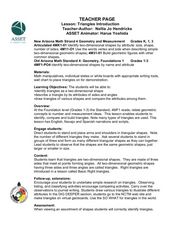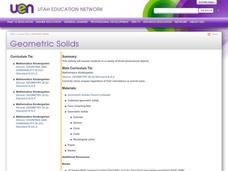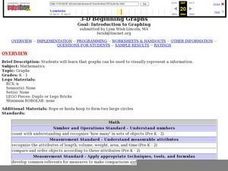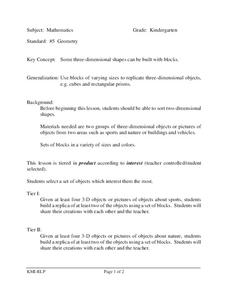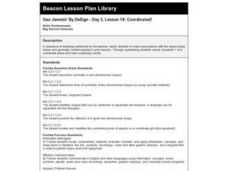Curated OER
Shapes...the Beginning of Geometry
Students identify and name basic shapes and points. In this elementary geometry lesson plan, students use printable cut outs to name circles, triangles, and squares before playing a game with them. They play a game of "Pin the Tail on...
Curated OER
Isosceles Triangles
Students investigate triangles. In this shapes geometry lesson, students define and state the attributes for equilateral, scalene, and isosceles triangles. Students locate the prefix "tri" in a variety of words and make connections with...
Pennsylvania Department of Education
Creating Polygons
Students describe, make and compare polygons. In this creating polygons instructional activity, students identify properties of quadrilaterals and describe common features of two dimensional shapes.
Curated OER
Magician Squares
Elementary school learners investigate the attributes of a square. They discover that squares are polygons and examine squares found in everyday life. They concentrate on connecting the word, square, with the shape. As an extension,maybe...
Alabama Learning Exchange
Twisted Tangrams
Primary geometers create a picture using tangrams. In this geometry lesson, students read Grandfather Tang: A Tale Told with Tangrams, cut out their own tangrams, and choose a character from the story to make using their tangram pieces.
Curated OER
Triangles and Things
Young learners listen to the story book The Greedy Triangle as the teacher introduces new polygon shapes. They use geometric stencils to trace a quadrilateral, a pentagon, a hexagon, and an octogon onto a foldable notepad. They identify...
Pennsylvania Department of Education
Geoboards
Students describe shapes to their classmates using specific properties and practice making triangles on geoboards. In this geoboards lesson plan, students use string on the geoboards.
Curated OER
Triangles Introduction
Students explore geometry by drawing various shapes in class. In this triangle characteristics lesson plan, students identify the attributes that classify a shape as a triangle and practice using their bodies to create triangles in...
Curated OER
Geometric Solids
Students identify and create simple geometric shapes and describe simple spatial relationships. Through discussion, hands-on activities and show and tell, they identify geometric solids in real life and create graphs of commonly found...
Curated OER
Small and Large Squares
Young mathematicians classify squares according to attributes. They sort squares according to specific attributes. Students explore squares in repeating patterns and order squares according to size. Engaging extension activities are...
Curated OER
Mondrian, Math, and Amazing Colors
Students study geometric shapes, lines, and the primary colors as they create Mondrian-like art prints.
Curated OER
Six Squares
Students create different shapes on grid paper. In this two-dimensional geometry lesson, students take turns outlining a shape made of six squares on the graph paper. They identify all shapes they see once everyone has had a turn.
Curated OER
Who's In The Fact Family?
Students study related addition and subtraction facts. In this math lesson, students use related addition and subtraction to solve problems. Students use manipulatives to explore fact families.
Pennsylvania Department of Education
Extending Pattern Understandings
Learners use shapes and manipulatives to demonstrate patterns. In this patterns lesson plan, students also break up patterns to identify a pattern unit.
Arizona State University
Tricorn Triangles
Help your learners examine triangles. Pupils explore the different sizes and measurements of triangles. They discover triangles can be isosceles or scalene, and examine the attributes of triangles. Here is the website where you can find...
Curated OER
3-D Beginning Graphs
Students explore the concept of big and small. They collect objects from the classroom, sort them by size, and create a graph using Duplo stacking blocks.
Curated OER
Making Rectangles
Students study rectangles. In this math lesson, students use numbers, measurements and geometry to draw rectangles of varying sizes.
Curated OER
Geometry
Students build replicas about nature and sports. In this geometry lesson plan, students build 3D replicas of nature and sports objects in teams.
Curated OER
Mother Nature Pattern Maker
Young scholars in a teacher education program enhance their awareness of patterns. They discover how to support their students in developing this skill in mathematical terms. They role play the role of a K-2 student and collect images...
Curated OER
Sled Kite
Students make and fly a sled kite out of plastic garbage bags, dowel rods, and more. In this kite lesson plan, students plan the kite to have symmetry and make adjustments as they test it.
Curated OER
Learning by Sorting
Students sort Lego Duplo pieces after determining the attributes to classify them by. They work in pairs to sort a group of Duplo pieces and explain their process to others.
Curated OER
Geo Jammin By Design: Coordinated
Students watch the teacher draw on the chalkboard and try to determine the form being drawn. They use questions to determine Quadrant #1 of a coordinate plane.









